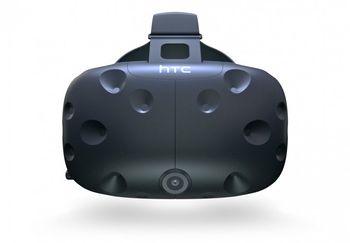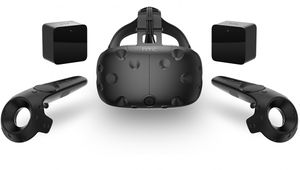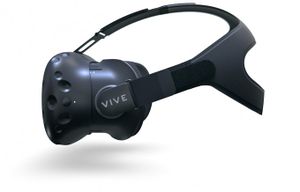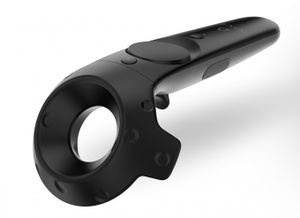HTC Vive: Difference between revisions
Shadowdawn (talk | contribs) |
Shadowdawn (talk | contribs) |
||
| Line 48: | Line 48: | ||
==Hardware== | ==Hardware== | ||
===Review=== | |||
'''Design and Ergonomics''': | |||
The all-black HMD is sleek and sturdy. It is secured to the user's head with a harness-like series of straps. The user's face contacts the HMD with a soft and comfortable facial interface. The foam gasket part of the interface can be removed and replaced by lifting it from the velcro. Vive comes with 2 foam gaskets: the larger "Wide Face" and the smaller "Thin Face". The You can change the distance between the [[lenses]] to fit your [[IPD]] with the dial on the right side of HMD. [[Eye relief]], the distance between the lenses and your eyes, can be adjusted with 2 gray dials that you can pull out and rotate to extend or retract the sides of the HMD. While this function allows the Vive to accommodate most glasses, please be aware that increasing the eye relief does affect the [[FOV]]. | |||
'''Display and Optics''': | |||
Vive features dual OLED panel displays of 1080 x 1200 per eye. The colors are vibrant, the [[resolution]] is adequate and the [[screen door effect]] is minimal. The only glaring flaw of Vive's display and optics system is the [[god rays]]. The god rays are caused by [[Fresnel lenses]]' ridges which scatter light. They look similar to lens flares and are noticeable whenever there are high contract elements on the screen i.e. white text on a black background. | |||
'''Front facing camera''': | |||
A camera is located in the front, bottom of the HMD. The camera can bring up a wide [[FOV]] view of the environment that is in front of you. Players can activate the camera by double tapping of SteamVR controller's "System" button or set it to automatically activate when you wander too close to the [[Chaperone]] boundaries. Working in conjunction with Chaperone, the camera create another layer that keeps the player safe while moving around wearing the HMD. | |||
'''Tracking''': | |||
[[Tracking]] in Vive has no visible [[latency]]. The [[Tracking#Systems|tracking system]] employed by HTC Vive is called [[Lighthouse]]. While [[rotational tracking]] is achieved with [[IMUs]], [[positional tracking]] is accomplish with 2 IR base stations called [[Beacons]]. The Beacons would constantly flood the room with IR that are detected by sensors on the HMD and [[SteamVR Controllers]]. HMD and controllers would figure out where they are in relation to the Beacons ([[inside-out tracking]]). Vive's tracking is designed for both [[Seated VR|seated]], [[standing VR|standing]] and most importantly [[Room-scale VR]] experiences. | |||
Vive is designed to accurately track the position and orientation of the HMD and [[SteamVR Controllers|controllers]] within 15 by 15 feet space. | |||
'''Voice and Audio''': | |||
Vive has a built-in mic but does not have built-in headphones. It comes with a set of earbuds that can be plugged into a headphone jack extending from the HMD. | |||
'''Cables and Ports''': | |||
===In The Box=== | ===In The Box=== | ||
A. 2 Base Stations | A. 2 [[Base Stations]] | ||
B. Sync cable - optional | B. Sync cable - optional | ||
| Line 80: | Line 105: | ||
P. 2 Micro-USB charger | P. 2 Micro-USB charger | ||
===Specifications=== | ===Specifications=== | ||
Revision as of 17:46, 4 May 2016
| HTC Vive | |
|---|---|

| |
| Basic Info | |
| VR/AR | Virtual Reality |
| Type | Head-mounted display |
| Subtype | Discrete HMD |
| Platform | SteamVR |
| Developer | HTC, Valve |
| Release Date | April 5, 2016 |
| Price | $799, €899, £689 |
| Website | http://www.htcvr.com/ |
| Requires | PC |
| Predecessor | HTC Vive Pre |
| Successor | HTC Vive CV2 |
| System | |
| Operating System | Windows |
| Storage | |
| Display | |
| Display | Dual Panel |
| Resolution | 2160 x 1200 (1080 x 1200 per eye) |
| Pixel Density | 455.63 PPI per eye |
| Refresh Rate | 90 Hz |
| Image | |
| Field of View | 110° (diagonal) |
| Optics | |
| Optics | Fresnel Lenses |
| Tracking | |
| Tracking | 6DOF |
| Rotational Tracking | Gyroscope, Accelerometer, Laser Position Sensor |
| Positional Tracking | Beacons |
| Update Rate | Rotational: 1000Hz, Positional: 60Hz |
| Tracking Volume | 120°H x 120°V (over 21 feet range) |
| Latency | ?? |
| Audio | |
| Audio | Built-in headphones, external headphones |
| Camera | Pass-through camera |
| Connectivity | |
| Connectivity | 2 HDMI ports, 2 USB ports, 1 headphone jack |
| Device | |
| Input | Controllers in both hands |
| Cable Length | 5+ meters |
- See also: HTC Vive Developer Editions
HTC Vive also known as HTC Vive CV1 or simply as the Vive is the first consumer version of HTC Vive Virtual Reality HMD developed by HTC. It is part of the SteamVR ecosystem created by Valve.
Pre-orders for the Vive begins on February 29, 2016 for $799. Vive released on April 5, 2016. HTC Vive CV1 comes with the head-mounted display, 2 wireless, motion tracked controllers and 2 lighthouse beacon positional sensors that enable room-scale VR.
Features
- Room-scale VR - Move around freely in a 15 feet by 15 feet space. Both HMD and the 2 controllers are accurately tracked within that space.
- Wireless SteamVR Controllers - Input with 2 motion-tracked controllers, 1 held in each hand.
- Chaperone - Prevents the user from bumping into real life walls and other obstacles.
- Front facing camera - Allows the user see the real life environment in front of them while wearing the HMD.
- Smartphone connectivity - Connect the HMD to your smartphone via Bluetooth, allowing the user to receive calls, messages remainders and return calls.
Hardware
Review
Design and Ergonomics:
The all-black HMD is sleek and sturdy. It is secured to the user's head with a harness-like series of straps. The user's face contacts the HMD with a soft and comfortable facial interface. The foam gasket part of the interface can be removed and replaced by lifting it from the velcro. Vive comes with 2 foam gaskets: the larger "Wide Face" and the smaller "Thin Face". The You can change the distance between the lenses to fit your IPD with the dial on the right side of HMD. Eye relief, the distance between the lenses and your eyes, can be adjusted with 2 gray dials that you can pull out and rotate to extend or retract the sides of the HMD. While this function allows the Vive to accommodate most glasses, please be aware that increasing the eye relief does affect the FOV.
Display and Optics:
Vive features dual OLED panel displays of 1080 x 1200 per eye. The colors are vibrant, the resolution is adequate and the screen door effect is minimal. The only glaring flaw of Vive's display and optics system is the god rays. The god rays are caused by Fresnel lenses' ridges which scatter light. They look similar to lens flares and are noticeable whenever there are high contract elements on the screen i.e. white text on a black background.
Front facing camera:
A camera is located in the front, bottom of the HMD. The camera can bring up a wide FOV view of the environment that is in front of you. Players can activate the camera by double tapping of SteamVR controller's "System" button or set it to automatically activate when you wander too close to the Chaperone boundaries. Working in conjunction with Chaperone, the camera create another layer that keeps the player safe while moving around wearing the HMD.
Tracking:
Tracking in Vive has no visible latency. The tracking system employed by HTC Vive is called Lighthouse. While rotational tracking is achieved with IMUs, positional tracking is accomplish with 2 IR base stations called Beacons. The Beacons would constantly flood the room with IR that are detected by sensors on the HMD and SteamVR Controllers. HMD and controllers would figure out where they are in relation to the Beacons (inside-out tracking). Vive's tracking is designed for both seated, standing and most importantly Room-scale VR experiences.
Vive is designed to accurately track the position and orientation of the HMD and controllers within 15 by 15 feet space.
Voice and Audio:
Vive has a built-in mic but does not have built-in headphones. It comes with a set of earbuds that can be plugged into a headphone jack extending from the HMD.
Cables and Ports:
In The Box
A. 2 Base Stations
B. Sync cable - optional
C. 2 Base station power adapter
D. Mount kit
E. Link box
F. Link box mounting pad
G. Link box power adapter
H. HDMI cable
I. USB cable
J. Earbuds
K. Alternate face cushion (narrow) -
L. Cleaning cloth
M. Documentation
N. Headset with 3-in-1 cable and audio cable
O. 2 Controllers (with lanyard)
P. 2 Micro-USB charger
Specifications
| Part | Spec |
|---|---|
| Display | Dual OLED Panels |
| Resolution | 2160 x 1200 (1080 x 1200 per eye) |
| Pixel density | ??? |
| Refresh rate | 90 Hz |
| Persistence | Low |
| Field of View | 110° (diagonal) |
| Optics | Fresnel lenses |
| IPD | 60.2-74.5mm |
| Tracking | 6 degrees of freedom |
| Rotational tracking | Gyroscope, Accelerometer, Magnetometer |
| Positional tracking | Beacons |
| Update Rate | Rotational: 1000Hz, Positional: 60Hz |
| Tracking Volume | 120°H x 120°V (>21 feet range) |
| Latency | |
| Connectivity | Multi-part cable with HDMI, USB and power that is connected to a junction box |
| Weight | 555 grams (1.2 pounds) |
System Requirements
Recommended
- GPU: NVIDIA® GeForce® GTX 970, AMD Radeon™ R9 290 equivalent or better
- CPU: Intel® i5-4590 / AMD FX 8350 equivalent or better
- RAM: 4 GB or more
- Video Output: HDMI 1.4, DisplayPort 1.2 or newer
- USB Port: 1x USB 2.0 or better port
- Operating System: Windows 7 SP1, Windows 8.1 or later, Windows 10
SteamVR Performance Test
SteamVR Performance Test is a benchmark software that checks if your system is ready for Vive. It checks your system's OS, GPU and CPU to see if it has the capability of running VR at 90 FPS and whether VR content can tune the visual fidelity up to the recommended level.
Play Area Requirements
Room-scale VR
- 2 m x 1.5 m (6 feet 6 inches x 5 feet) minimum room size
- 5 m (16 feet) maximum between base stations
Standing/Seated VR
- No minimum space requirements
Setup Tutorial
Input Devices
SteamVR Controllers - 1 held in each hand, these controllers are tracked by the same system as the HMD (Lighthouse).
Other devices compatible with Steam
Apps
HTC Vive CV1 is shipped with 3 free games: Job Simulator: The 2050 Archives by Owlchemy Labs, Fantastic Contraption by Northway Games and Tilt Brush by Google.
Connecting to Your Phone
Users can install the Vive mobile app on their phone from the App Store[1] or Google Play[2]. The apps enable your HTC Vive HMD to connect to your mobile phones through Bluetooth. It allows your Vive HMD to receive calls, texts and calendar reminders while your are in VR.
To make phone calls, users need to download the Vive software package [3] for their PC. Now when you receive a call or text, you'll be able to call back the individual through the Vive menu.
Developer
Tracking volume
- See also: Tracking volume
120°H x 120°V (>21 feet range)
History
February 29, 2016 - Pre-orders for HTC Vive CV1 begin.
April 5, 2016 - HTC Vive CV1 is officially released.




